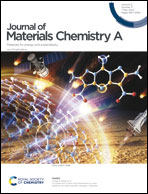Sustainable CO2 adsorbent via amine–phosphate coupling of glycated chitosan and electrochemically exfoliated graphene†
Abstract
This study introduces a novel approach for generating highly effective CO2 adsorbents derived from glycated chitosan (GC) and electrochemically exfoliated graphene (EEG) nanoplatelets. The significant enhancement in the CO2 adsorption capacity of EEG–GC aerogels in comparison to their building blocks is achieved by inducing mesoporosity enabled by linking amine groups on GC and phosphate groups on EEG. The glycation of chitosan facilitates its enhanced dispersion in water, and effectively eliminates its amorphous parts, leading to a bimodal particle size distribution. The extent of glycation and the weight ratio of EEG to GC affect the precursor gel's microstructure and mesoporosity in the derived aerogels, with optimal conditions identified. The derived aerogels demonstrate exceptional CO2 adsorption capacity of 2.88 mmol g−1 and CO2/N2 selectivity of 43.8, at 298 K and 1 bar, and can be regenerated employing Joule heating with minimal reduction in adsorption capacity (demonstrated for 20 cycles). These findings highlight the innovative use of amine–phosphate coupling along with the bimodal distribution of GC to induce mesoporosity, providing new avenues for developing effective CO2 adsorbents for industrial use.



 Please wait while we load your content...
Please wait while we load your content...